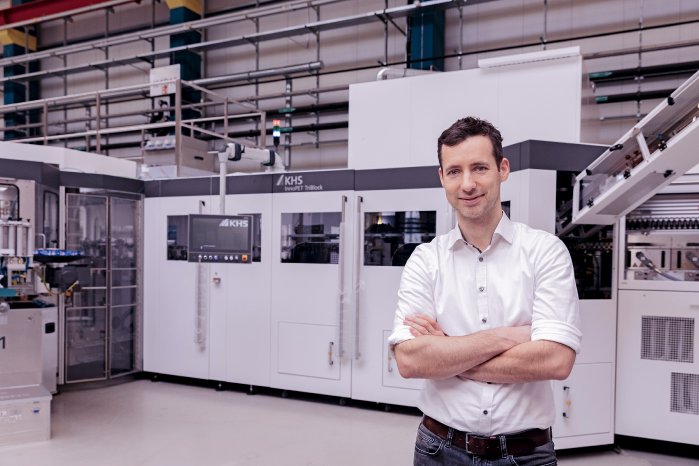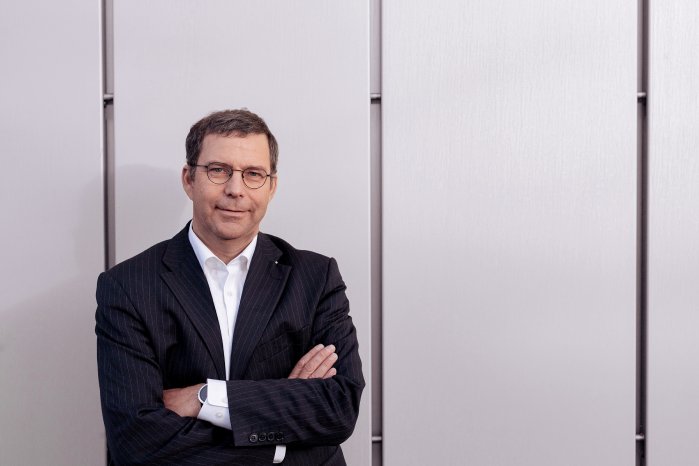With this new tool KHS is adding a further component to its holistic packaging services. In cooperation with the Hamburg Institute for Environmental IT (ifu), a leading independent international software developer for material and energy flow analyses, the Dortmund systems provider clearly shows its customers which style of packaging has which impact on the climate and whether a conversion for a stretch blow molder, for instance, has a positive effect on their carbon footprint or not. “Besides economy and efficiency in beverage production, our agenda focuses primarily on reducing the ecological footprint,” explains Dennis Jacobi, service sales manager and expert for conversions at KHS.
Carbon footprint much smaller following conversion
This objective can be reached by modernizing KHS stretch blow molders already on the market, for instance: by converting heaters and recovering compressed air in the stretch blow molding process, energy is saved during bottle production and the carbon footprint thus considerably reduced. In heaters the main factor is the thermal energy that is needed to heat up the preforms before they pass through the stretch blow molding process. “Depending on the machine generation and equipment, our conversions save up to 45% in energy during heating,” Jacobi states. Recycling the air also helps to cut down on the amount of energy consumed. “The compressed air required for the stretch blow molding process is generated by a compressor and usually vented to the production shop after use through a valve. This air is then lost. An upgrade with our AirbackPlus technology, however, returns it to a ring line and uses it to blow mold the next container. This means that the compressor has less to do, thus cutting the amount of electricity needed by up to 40%.”
Carbon footprint for conversions
How this type of conversion that KHS has had in its program for ten years now specifically effects the beverage filler’s carbon footprint can be calculated more accurately with the new tool. “To date, we were able to calculate exactly how many kilowatt hours the conversion reduces the annual electricity consumption by; however, how much CO2 we save in the end and how sustainable this actually is as a result is something we didn’t know until now because we couldn’t set it against the amount of CO2 generated by the measure itself,” says Jacobi.
In principle, the solution is a simple Excel tool fed with data where in a first step all parameters that impact the climate are recorded in the entry mask. These include, for instance, the materials used for the conversion, packaging, transportation and the distance engineers have to travel for installation. The tool then computes how much CO2 has been ‘spent’ on the conversion. In a second step the number of kilowatt hours the conversion has saved is then entered in the computer, plus the customer’s location and which type of electricity it uses or itself produces. Once combined, these figures show how long it takes for the CO2 expended during the conversion to be neutralized. “This is the customer’s ecological return on investment, so to speak,” smiles Jacobi. “What’s very pleasing here is that as our conversions save so much energy, they usually balance out their ecological footprint within just a few days or weeks.” In view of rising energy prices, the cost benefits are of course a primary concern for lots of customers. However, “in light of increasing regulation that rewards CO2 savings with tax benefits or grants, for example, the environmental aspect is also becoming ever more important. Furthermore, a growing number of companies have committed themselves to ambitious climate targets,” observes Jacobi.
Carbon neutrality a key aim for many beverage producers
This is also something Arne Wiese has noticed, who as Bottles & Shapes product manager advises KHS customers on container design and manufacture. “Lots of beverage producers want to become carbon neutral and are asking us which type of packaging has the lowest carbon footprint,” he says. In order to be able to express the respective advantages of a particular container in figures and help beverage bottlers reach a decision as to which kind of packaging will prove to be the most climate-friendly for them, the tool is used to compare various styles of primary packaging with one another, such as PET bottles made of recycled or virgin material, glass bottles, beverage cans, HDPE containers and carton packs, with respect to the impact they have on the environment. The calculation takes into account not just the material but also the bottler’s location, container weight, transportation routes and number of cycles of use. The calculation tool also considers the consumption of water and chemicals during cleaning and how the packaging is disposed of at the end of its life. The greenhouse gas emissions are computed separately and in combination for each area as CO2 equivalents and provide information on which container type has the best ecobalance throughout its entire life cycle. “With our primary packaging carbon calculator we chiefly score in those areas where PET can be used as an alternative to HDPE,” states Wiese. “In the milk and mixed milk beverage, cosmetic and household segments, for instance, more and more environmentally-aware customers are being convinced that PET containers are the more ecofriendly alternative.” Wiese is convinced that this data serves as a reliable guide and triggers change processes that result in packaging that is gentler on the climate.
Secondary packaging calculator rounds off the service
The KHS service is rounded off by a program that calculates the carbon footprint of secondary packaging. To facilitate its development the engineering company supplied Hamburg’s ifu institute with the parameters for all of the packaging options in its entire portfolio to enable their global warming potential (GWP) to be calculated according to DIN EN ISO 14067*. “In this context we measured the respective electricity, gas, compressed air and lubricating oil consumption on the various machines,” explains Andre Fortkord, the adhesives process engineer in charge of the project. The consumption data provided was combined with the material data for film, corrugated cardboard and adhesive stored in the ecoinvent database and with the average values for transportation routes valid in the EU so that we can compute the GWP for each individual pack.” Using the selected options in the entry mask and taking the quantities entered by hand, the tool can quickly calculate that a film pack on a tray clocks up 0.11 kilograms of CO2 equivalents, whereas a tray paper pack only generates 0.085 of the same, for example, depending on various parameters. “This instrument is being positively received by our customers,” says Fortkord, who sees KHS in a pioneering role. In order to be able to produce informative, up-to-the-minute results in the future, too, the stored data needs to be updated at regular intervals.
* DIN EN ISO 14067: Greenhouse gases – Carbon footprint of products– Requirements and guidelines for quantification.



